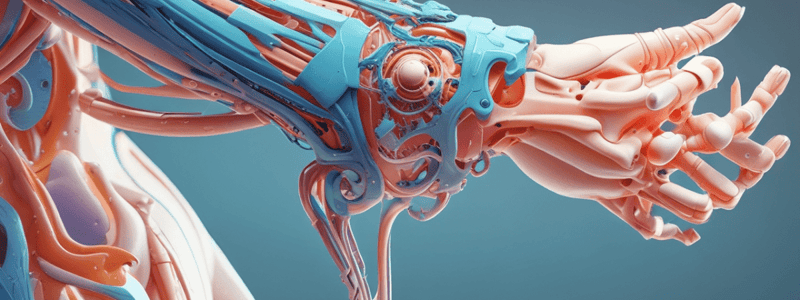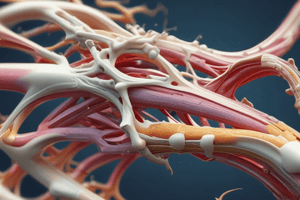Podcast
Questions and Answers
Chondrocytes are nourished by blood vessels.
Chondrocytes are nourished by blood vessels.
False (B)
Avascular means that the tissue has a rich blood supply.
Avascular means that the tissue has a rich blood supply.
False (B)
Fibrocartilage is primarily composed of type II collagen fibers.
Fibrocartilage is primarily composed of type II collagen fibers.
False (B)
Fibrocartilage is located in the intervertebral discs.
Fibrocartilage is located in the intervertebral discs.
Chondrocytes and fibroblasts in fibrocartilage are highly innervated.
Chondrocytes and fibroblasts in fibrocartilage are highly innervated.
Fibrocartilage provides resilience but not shock absorption.
Fibrocartilage provides resilience but not shock absorption.
Bone is classified as a specialized form of epithelial tissue.
Bone is classified as a specialized form of epithelial tissue.
Bone forms the internal levers of the musculoskeletal system.
Bone forms the internal levers of the musculoskeletal system.
Fibrocartilage primarily functions to provide tensile strength to ligaments and tendons.
Fibrocartilage primarily functions to provide tensile strength to ligaments and tendons.
In a convex-on-concave surface movement, the convex member rolls and slides in the same directions.
In a convex-on-concave surface movement, the convex member rolls and slides in the same directions.
Abduction without a concurrent inferior slide causes the humeral head to impinge against the arch and block further abduction.
Abduction without a concurrent inferior slide causes the humeral head to impinge against the arch and block further abduction.
In a concave-on-convex surface movement, the concave member rolls and slides in opposite directions.
In a concave-on-convex surface movement, the concave member rolls and slides in opposite directions.
Roll-and-Slide movements are commonly observed in saddle-shaped joints.
Roll-and-Slide movements are commonly observed in saddle-shaped joints.
The close-packed position of a joint is characterized by minimal congruency.
The close-packed position of a joint is characterized by minimal congruency.
Joint structures that are lax may lead to excessive joint play and instability.
Joint structures that are lax may lead to excessive joint play and instability.
A trochoginglymus joint is relatively internally rotated when fully extended.
A trochoginglymus joint is relatively internally rotated when fully extended.
In combined movements involving Roll-and-Slide, the ball and socket shape joints exhibit this type of motion.
In combined movements involving Roll-and-Slide, the ball and socket shape joints exhibit this type of motion.
The maximal natural structural stability of a joint resists tensile forces that tend to cause compression of the joint surfaces.
The maximal natural structural stability of a joint resists tensile forces that tend to cause compression of the joint surfaces.
In osteokinematics, pure swing involves movement back and forth around a fixed pivot point in multiple planes.
In osteokinematics, pure swing involves movement back and forth around a fixed pivot point in multiple planes.
Degrees of freedom at a joint refer to the number of independent movements allowed.
Degrees of freedom at a joint refer to the number of independent movements allowed.
Passive range of motion requires the maximum force from the flexors in the outer range.
Passive range of motion requires the maximum force from the flexors in the outer range.
Distraction and compression are types of angular motions in osteokinematics.
Distraction and compression are types of angular motions in osteokinematics.
The end feel refers to the initial resistance felt while initiating a passive range of motion.
The end feel refers to the initial resistance felt while initiating a passive range of motion.
Joint play is increased in the close-packed position.
Joint play is increased in the close-packed position.
Osteokinematics in biomechanics includes swing, which is rotation around a joint axis.
Osteokinematics in biomechanics includes swing, which is rotation around a joint axis.
The physiological barrier is located at the inner range of motion.
The physiological barrier is located at the inner range of motion.
The relative incongruency in joints provides increased natural structural stability.
The relative incongruency in joints provides increased natural structural stability.
Viscoelastic materials exhibit time-dependent properties when forces are applied to them.
Viscoelastic materials exhibit time-dependent properties when forces are applied to them.
Creep is a phenomenon that occurs when a material is exposed to low-stress levels for a short period of time.
Creep is a phenomenon that occurs when a material is exposed to low-stress levels for a short period of time.
Changes in temperature have no effect on the rate of creep in viscoelastic materials.
Changes in temperature have no effect on the rate of creep in viscoelastic materials.
When viscoelastic materials are loaded rapidly, they exhibit less resistance to deformation compared to when they are loaded slowly.
When viscoelastic materials are loaded rapidly, they exhibit less resistance to deformation compared to when they are loaded slowly.
Healthy tissues are always able to resist changes in their shape regardless of any external forces.
Healthy tissues are always able to resist changes in their shape regardless of any external forces.
Connective tissue structures should be stretched using a small load over a short period of time to produce creep.
Connective tissue structures should be stretched using a small load over a short period of time to produce creep.
The deformation of viscoelastic materials is not affected by the duration of the applied force.
The deformation of viscoelastic materials is not affected by the duration of the applied force.
The resistance to deformation in viscoelastic materials decreases with both higher rate and longer duration of applied force.
The resistance to deformation in viscoelastic materials decreases with both higher rate and longer duration of applied force.
Forces applied to viscous materials have no potential to deform or injure the body.
Forces applied to viscous materials have no potential to deform or injure the body.
Stress is calculated as force divided by volume.
Stress is calculated as force divided by volume.
Zone A in the stress-strain curve represents the linear region.
Zone A in the stress-strain curve represents the linear region.
Strain refers to a change in shape, length, or width of a material due to stress.
Strain refers to a change in shape, length, or width of a material due to stress.
The energy used to deform tissue in the elastic zone is mostly retained when the deforming force is removed.
The energy used to deform tissue in the elastic zone is mostly retained when the deforming force is removed.
Mechanical stresses are created within a structure when external forces are applied.
Mechanical stresses are created within a structure when external forces are applied.
The tension generated by an excised ligament is not related to its mechanical failure point.
The tension generated by an excised ligament is not related to its mechanical failure point.
Zone B in the stress-strain curve represents the region where the tissue returns to its original shape.
Zone B in the stress-strain curve represents the region where the tissue returns to its original shape.
Deformation of a solid or semisolid material does not involve strain.
Deformation of a solid or semisolid material does not involve strain.
The nature of stress and strain in human structures is only dependent on the magnitude of the load applied.
The nature of stress and strain in human structures is only dependent on the magnitude of the load applied.




